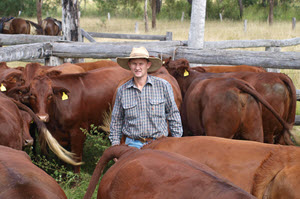Smarter data is the way forward

With 25 years of cattle performance recording under their belt, David and Sonya Greenup see the Repronomics project as an exciting new era.
The Greenups’ Rosevale Santa Gertrudis stud is one of the major co-operators of the Repronomics herds. David and Sonya believe industry contribution will create more linkages between bloodlines and provide more accurate information on the breed’s up-and-coming sires. The Greenups run 700 commercial breeders and 700 stud breeders on 12,000ha at Jandowae, Queensland.
Progressing northern herds’ fertility
The MLA-funded Repronomics project is designed to deliver new genetic assessment tools and accelerate the progress of the northern beef herd by focusing on fertility. Now in its fourth year, the project has seen the artificial insemination of more than 3,000 cows in beef research station hers, using semen from young bulls.
Milestones to date include new tools such as Brahman BREEDPLAN achieving single-step genomic analysis, measurement of meat and carcase quality traits and development of across-breed estimated breeding values (EBVs) comparing individual traits on Brahmans, Droughtmaster and Santa Gertrudis.
Breeding for profitability
“We’re trying to breed animals that will lift herd profitability in all environments,” David Greenup said.
“We’re focused on a wide range of traits including fertility, docility, growth, carcase specifications, structural soundness and polledness – but because fertility (both male and female) is such a dominant profit driver, it is our first selection criterion, and other traits must follow.
“It’s quite difficult to source new genetics that tick all those boxes.”
The Greenups use the days to calving EBV to measure fertility and focus heavily on semen morphology, demanding higher than usually acceptable counts.
“We find this trait correlates heavily with female fertility and, if bulls are working under stress, those that exhibit a higher percentage of normal sperm are more likely to remain fertile longer than animals with lower counts,” he said.
“The accepted norm is 70%, but we aim for 85% and above for the sires we use.”
The future of Repronomics
David believes the Santa Gertrudis breed will reap the rewards of Repronomics within five years.
“Changing the genetic direction in a herd takes time and, at this stage, it’s about building the volume of data – especially in traits that are costly and hard to measure. As we do that, the accuracies of our EBVs, and our ability to make better selection decisions using them, will build over time,” he said.
“To be able to pull some tail hairs and know, with a high level of accuracy, what a young bull or heifer is capable of, is one of the breakthroughs we’re looking forward to.”
David said more clients are realising the benefits of selecting animals using EBVs.
“We have a wave of producers who are really focused on performance data when making buying decisions,” he said.
“Plenty of bulls ‘look the part’ but potentially will decrease herd profitability if, for example, they leave behind daughters that are slow breeders.”
Lessons learned
- Semen morphology has a strong correlation to female fertility.
- Project data will bolster BREEDPLAN analysis and make it easier to identify genetics with desirable performance in traits that drive herd profitability.
More information
David and Sonya Greenup
E: rosevalesanta@bigpond.com
For information on the Repronomics' project:
Dr David Johnston
T: 02 6773 2658
E: djohnsto@une.edu.au
futurebeef.com.au/repronomicstm
Animal Genetics and Breeding Unit: agbu.une.edu.au
BREEDPLAN: breedplan.une.edu.au



